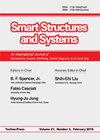A fast image-stitching algorithm for characterization of cracks in large-scale structures
IF 2.2
3区 工程技术
Q2 ENGINEERING, CIVIL
引用次数: 1
Abstract
Visual inspection of concrete cracks has been widely used in structural health monitoring (SHM). Capturing highresolution images is an effective method to visualize a complete crack, but it is difficult to show a whole crack from a single high-resolution image. One feasible method is using image stitching technique to stitch several images into a complete crack map. However, the current image stitching method is a computationally intensive process. Numerous images are required to cover large-scale structures with sufficient resolution, this can be computationally prohibitive. To address this problem, an improved image stitching method for crack damage evaluation is proposed, which can quickly stitch the crack images without affecting the quality of the stitching or the resulting images. Rather than first stitching the images together and then determining the crack maps, we propose to first develop the crack maps for the individual images and then stitch them together. The proposed method reduces the number of redundant matching points between the original images by combining their characteristics during image stitching, so it can reduce the calculation time without affecting the quality. Also, the results will not be influenced by the image stitching seam, which can reduce the complexity of the algorithm. Several experimental results are provided in this article to demonstrate that the proposed method can reduce the calculation time without affecting the quality of image stitching and have better robustness than the current method in use.大型结构中裂纹特征的快速图像拼接算法
混凝土裂缝的目视检测在结构健康监测中得到了广泛的应用。获取高分辨率图像是可视化完整裂纹的有效方法,但很难从单个高分辨率图像中显示整个裂纹。一种可行的方法是使用图像拼接技术将多个图像拼接成一个完整的裂纹图。然而,当前的图像拼接方法是一个计算密集的过程。需要大量的图像来覆盖具有足够分辨率的大型结构,这在计算上可能是令人望而却步的。为了解决这个问题,提出了一种用于裂纹损伤评估的改进图像拼接方法,该方法可以快速拼接裂纹图像,而不会影响拼接或生成图像的质量。我们建议首先为各个图像开发裂纹图,然后将它们缝合在一起,而不是首先将图像缝合在一起然后确定裂纹图。该方法结合原始图像拼接过程中的特征,减少了原始图像之间冗余匹配点的数量,从而在不影响质量的情况下减少了计算时间。此外,图像拼接接缝不会影响结果,这可以降低算法的复杂性。本文提供的几个实验结果表明,该方法可以在不影响图像拼接质量的情况下减少计算时间,并且比目前使用的方法具有更好的鲁棒性。
本文章由计算机程序翻译,如有差异,请以英文原文为准。
求助全文
约1分钟内获得全文
求助全文
来源期刊

Smart Structures and Systems
工程技术-工程:机械
CiteScore
6.50
自引率
8.60%
发文量
0
审稿时长
9 months
期刊介绍:
An International Journal of Mechatronics, Sensors, Monitoring, Control, Diagnosis, and Management airns at providing a major publication channel for researchers in the general area of smart structures and systems. Typical subjects considered by the journal include:
Sensors/Actuators(Materials/devices/ informatics/networking)
Structural Health Monitoring and Control
Diagnosis/Prognosis
Life Cycle Engineering(planning/design/ maintenance/renewal)
and related areas.
 求助内容:
求助内容: 应助结果提醒方式:
应助结果提醒方式:


